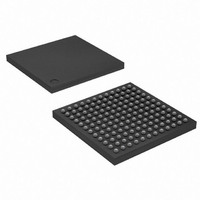AT91SAM9R64-CU Atmel, AT91SAM9R64-CU Datasheet - Page 241

AT91SAM9R64-CU
Manufacturer Part Number
AT91SAM9R64-CU
Description
MCU ARM9 64K SRAM 144-LFBGA
Manufacturer
Atmel
Series
AT91SAMr
Specifications of AT91SAM9R64-CU
Core Processor
ARM9
Core Size
16/32-Bit
Speed
240MHz
Connectivity
EBI/EMI, I²C, MMC, SPI, SSC, UART/USART, USB
Peripherals
AC'97, POR, PWM, WDT
Number Of I /o
49
Program Memory Size
32KB (32K x 8)
Program Memory Type
ROM
Ram Size
72K x 8
Voltage - Supply (vcc/vdd)
1.08 V ~ 1.32 V
Data Converters
A/D 3x10b
Oscillator Type
Internal
Operating Temperature
-40°C ~ 85°C
Package / Case
144-LFBGA
Processor Series
AT91SAMx
Core
ARM926EJ-S
Data Bus Width
32 bit
Data Ram Size
64 KB
Interface Type
2-Wire, SPI, SSC, USART
Maximum Clock Frequency
240 MHz
Number Of Programmable I/os
118
Number Of Timers
4
Maximum Operating Temperature
+ 85 C
Mounting Style
SMD/SMT
3rd Party Development Tools
JTRACE-ARM-2M, MDK-ARM, RL-ARM, ULINK2
Development Tools By Supplier
AT91SAM-ICE, AT91-ISP, AT91SAM9RL-EK
Minimum Operating Temperature
- 40 C
On-chip Adc
10 bit, 3 Channel
Controller Family/series
AT91SAM9xxx
No. Of I/o's
49
Ram Memory Size
64KB
Cpu Speed
240MHz
No. Of Timers
3
Rohs Compliant
Yes
Package
144LFBGA
Device Core
ARM926EJ-S
Family Name
91S
Maximum Speed
240 MHz
Operating Supply Voltage
1.8|3.3 V
For Use With
AT91SAM-ICE - EMULATOR FOR AT91 ARM7/ARM9
Lead Free Status / RoHS Status
Lead free / RoHS Compliant
Eeprom Size
-
Lead Free Status / Rohs Status
Lead free / RoHS Compliant
Available stocks
Company
Part Number
Manufacturer
Quantity
Price
Part Number:
AT91SAM9R64-CU
Manufacturer:
ATMEL/爱特梅尔
Quantity:
20 000
- Current page: 241 of 903
- Download datasheet (13Mb)
25.3
25.3.1
25.3.2
25.3.3
6289C–ATARM–28-May-09
Functional Description
Configuration
Memory Pointers
Transfer Counters
The PDC channel user interface enables the user to configure and control data transfers for
each channel. The user interface of each PDC channel is integrated into the associated periph-
eral user interface.
The user interface of a serial peripheral, whether it is full or half duplex, contains four 32-bit
pointers (RPR, RNPR, TPR, TNPR) and four 16-bit counter registers (RCR, RNCR, TCR,
TNCR). However, the transmit and receive parts of each type are programmed differently: the
transmit and receive parts of a full duplex peripheral can be programmed at the same time,
whereas only one part (transmit or receive) of a half duplex peripheral can be programmed at a
time.
32-bit pointers define the access location in memory for current and next transfer, whether it is
for read (transmit) or write (receive). 16-bit counters define the size of current and next transfers.
It is possible, at any moment, to read the number of transfers left for each channel.
The PDC has dedicated status registers which indicate if the transfer is enabled or disabled for
each channel. The status for each channel is located in the associated peripheral status register.
Transfers can be enabled and/or disabled by setting TXTEN/TXTDIS and RXTEN/RXTDIS in
the peripheral’s Transfer Control Register.
At the end of a transfer, the PDC channel sends status flags to its associated peripheral. These
flags are visible in the peripheral status register (ENDRX, ENDTX, RXBUFF, and TXBUFE).
Refer to
Each full duplex peripheral is connected to the PDC by a receive channel and a transmit chan-
nel. Both channels have 32-bit memory pointers that point respectively to a receive area and to
a transmit area in on- and/or off-chip memory.
Each half duplex peripheral is connected to the PDC by a bidirectional channel. This channel
has two 32-bit memory pointers, one for current transfer and the other for next transfer. These
pointers point to transmit or receive data depending on the operating mode of the peripheral.
Depending on the type of transfer (byte, half-word or word), the memory pointer is incremented
respectively by 1, 2 or 4 bytes.
If a memory pointer address changes in the middle of a transfer, the PDC channel continues
operating using the new address.
Each channel has two 16-bit counters, one for current transfer and the other one for next trans-
fer. These counters define the size of data to be transferred by the channel. The current transfer
counter is decremented first as the data addressed by current memory pointer starts to be trans-
ferred. When the current transfer counter reaches zero, the channel checks its next transfer
counter. If the value of next counter is zero, the channel stops transferring data and sets the
appropriate flag. But if the next counter value is greater then zero, the values of the next
pointer/next counter are copied into the current pointer/current counter and the channel resumes
the transfer whereas next pointer/next counter get zero/zero as values. At the end of this trans-
fer the PDC channel sets the appropriate flags in the Peripheral Status Register.
Section 25.3.3
and to the associated peripheral user interface.
AT91SAM9R64/RL64 Preliminary
241
Related parts for AT91SAM9R64-CU
Image
Part Number
Description
Manufacturer
Datasheet
Request
R

Part Number:
Description:
MCU, MPU & DSP Development Tools KICKSTART KIT FOR AT91SAM9 PLUS
Manufacturer:
IAR Systems

Part Number:
Description:
DEV KIT FOR AVR/AVR32
Manufacturer:
Atmel
Datasheet:

Part Number:
Description:
INTERVAL AND WIPE/WASH WIPER CONTROL IC WITH DELAY
Manufacturer:
ATMEL Corporation
Datasheet:

Part Number:
Description:
Low-Voltage Voice-Switched IC for Hands-Free Operation
Manufacturer:
ATMEL Corporation
Datasheet:

Part Number:
Description:
MONOLITHIC INTEGRATED FEATUREPHONE CIRCUIT
Manufacturer:
ATMEL Corporation
Datasheet:

Part Number:
Description:
AM-FM Receiver IC U4255BM-M
Manufacturer:
ATMEL Corporation
Datasheet:

Part Number:
Description:
Monolithic Integrated Feature Phone Circuit
Manufacturer:
ATMEL Corporation
Datasheet:

Part Number:
Description:
Multistandard Video-IF and Quasi Parallel Sound Processing
Manufacturer:
ATMEL Corporation
Datasheet:

Part Number:
Description:
High-performance EE PLD
Manufacturer:
ATMEL Corporation
Datasheet:

Part Number:
Description:
8-bit Flash Microcontroller
Manufacturer:
ATMEL Corporation
Datasheet:

Part Number:
Description:
2-Wire Serial EEPROM
Manufacturer:
ATMEL Corporation
Datasheet:











